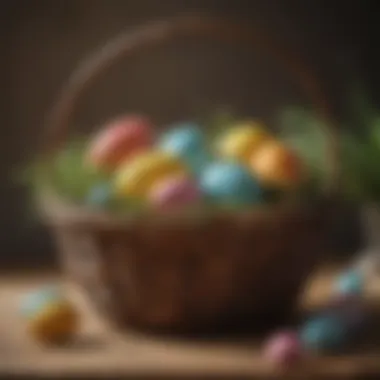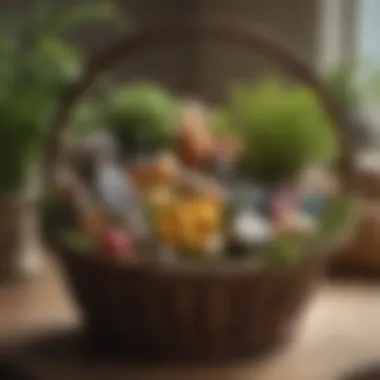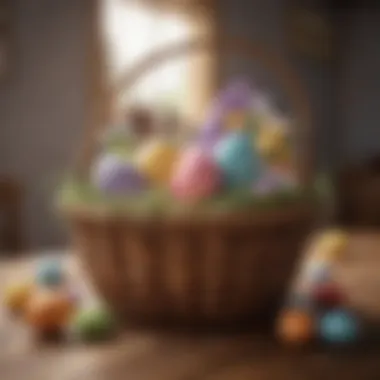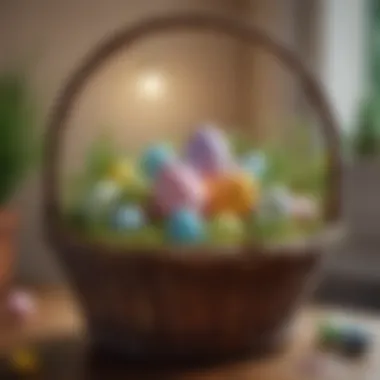Creative Easter Basket Ideas for Unique Celebrations


Intro
Easter is a time for renewal, reflection, and celebration. Crafting an Easter basket has traditionally been about filling it with chocolates, eggs, and a few decorative touches. However, innovative concepts now pave the way for more meaningful and personalized baskets that resonate with individual preferences and values.
This article seeks to explore a range of ideas that go beyond the conventional. Envision baskets that encapsulate specific themes, eco-friendly materials, and tailor-made gifts that cater to a diverse array of interests and lifestyles. Understanding the evolving nature of Easter celebrations will help you create memorable experiences that can be cherished beyond the annual holiday.
Let's dive into the different design inspirations and innovative ideas that will elevate your Easter baskets this year.
Design Inspirations
Creating an Easter basket is not merely about content but also about the design aspects that make it visually appealing and thematic. Here, we explore trending styles and color palettes that can guide your basket-making endeavor.
Trending Styles
In recent years, minimalistic designs have gained traction. A clean look with a focus on natural elements can often convey elegance. Consider using materials like wood or wicker that provide a rustic feel. You might also explore the charm of vintage or retro styles, which evoke nostalgia and warmth through patterns and historical touches.
Some popular styles include:
- Bohemian: Bright colors, various textures, and eclectic items bring a free-spirited vibe.
- Modern: Monochromatic themes with sleek lines make for a sophisticated presentation.
- Classic: Traditional motifs with soft pastels or earthy tones often resonate with a sense of familiarity.
Choosing a style that aligns with the recipient’s tastes will enhance the basket's appeal.
Color Palettes
Colors can set the mood and theme of your basket. Soft pastels like baby pinks, blues, and yellows are staple choices for Easter. However, incorporating deeper shades or even metallics can add a contemporary twist. Here are some potential palettes to consider:
- Pastel Paradise: Soft pinks, lavenders, and baby blues paired with neutral accents.
- Bold Contrasts: Bright yellows, vibrant greens, and rich reds for a lively feel.
- Earthy Tones: Greens, browns, and deep oranges to reflect a connection with nature.
Utilizing these color palettes not only elevates the aesthetic but also aligns with seasonal themes, giving your Easter basket a distinctive character.
Experiment with textures by incorporating elements like ribbons, fabric, or smooth finishes to create depth.
Maintenance and Upkeep
The work doesn't stop once the basket is made. Keeping it in good condition and ensuring it stays relevant throughout the season is vital. Here are some aspects to consider for maintenance and upkeep.
Seasonal Maintenance Checklist
To prolong the basket’s life and vibrancy, consider the following:
- Evaluate and sort the contents regularly.
- Replace any perishable items, ensuring freshness.
- Dust or clean the basket base to maintain its appearance.
Maintaining the basket ensures it serves as a decorative piece even after Easter.
Cleaning and Organization Tips
Keeping your basket organized enhances its usability. Here are some practical cleaning tips:
- Use a damp cloth with mild soap to clean the outer surfaces.
- For fabric elements, follow washing instructions carefully to avoid damage.
- Organize items according to size and type to avoid clutter.
By giving your Easter basket some extra attention, you ensure it remains a cherished part of your home decor, inviting future celebrations and creative expressions.
Ultimately, embracing innovative ideas for Easter baskets allows you to express individuality and thoughtfulness. Take the time to explore these concepts, and you may just discover new traditions that suit your style.
Preamble to Easter Basket Ideas
Crafting a unique Easter basket involves a thoughtful selection of themes and materials. It moves beyond the generic pastel colors to incorporate meaningful elements that resonate with the individual. From eco-friendly options to extravagant gourmet selections, these baskets can adapt to various preferences, making them suitable for all ages.
Understanding the Evolution of Easter Baskets
The history of Easter baskets dates back to the early traditions of Easter celebrations. Originally, these baskets were used by Christians to transport food that was blessed for the holiday. Over time, they morphed into decorative elements associated with the joy of spring. Today, they have transformed into a symbol of creativity and a platform for expression.
The contemporary approach to Easter baskets also reflects changing consumer behavior. With an increasing awareness of sustainability, many people are looking for eco-conscious alternatives. This includes using recyclable fabrics and biodegradable materials, which add an additional layer of thoughtfulness to the gifting process.


The Importance of Personalization
Personalization is at the heart of memorable gifting. An Easter basket tailored to someone’s specific tastes shows effort and care. This can be achieved through various means – selecting items that align with the recipient's hobbies or preferences is one such way. For instance, a basket filled with gardening tools and seeds for a gardening aficionado shows not only consideration of interests but also promotes engagement with the hobby.
Another approach to personalization is embracing experiential gifts. Instead of the usual candy items, consider including tickets to a concert, or a subscription service that caters to their interests. Such choices create lasting memories and reinforce relationships.
Personalization also provides an opportunity for sustainability. Choosing ethical products made by local artisans or supporting small businesses adds a unique touch while contributing positively to the community.
In summary, establishing innovative ideas for Easter baskets requires understanding the evolution and significance of personalization. It allows one to craft a thoughtful experience that is enjoyable and memorable for both the gifter and receiver.
Thematic Easter Basket Concepts
Exploring thematic Easter basket concepts enriches the holiday experience. Rather than defaulting to conventional gifts, these ideas offer a nuanced and purpose-driven approach. Themes allow for a coherent narrative in basket assembly, resonating with individual values and interests. Personalization is more pronounced when themes reflect the recipient's preferences. This concept encourages creativity and thoughtfulness, ensuring that the baskets are memorable.
Nature-Inspired Baskets
Baskets that embrace nature aspects can appeal to those who enjoy the outdoors or prioritize eco-friendly choices. These baskets contain elements that resonate with the beauty of nature, thus contributing to relaxation and tranquility.
Incorporating Plants
Integrating plants into Easter baskets enhances the aesthetic appeal while promoting sustainability. Succulents or small herb plants can act as lasting gifts that thrive long after Easter. Their key characteristic is growth, symbolizing renewal, appropriate for the season. This selection is a beneficial choice for its emotional impact, providing ongoing enjoyment rather than immediate consumption. The unique feature of this option lies in its environmental friendliness, encouraging a connection to nature. However, a potential disadvantage is the requirement for ongoing care; recipients need to tend to plants rather than merely enjoy them.
Using Earthy Materials
Incorporating earthy materials into baskets aligns with a growing interest in sustainability. Using natural fibers, like jute or straw, connects the basket to its surroundings. This is a popular choice as it evokes simplicity and authenticity. The unique feature of earthy materials is their tactile quality, offering a sensory experience that plastic cannot replicate. However, while these options are aesthetically pleasing, they may come at a higher cost compared to conventional materials.
Easter Basket for the Gourmet Enthusiast
For those who appreciate culinary delights, a gourmet-themed basket can be a source of joy. This concept recognizes the sensory pleasures of taste and experimentation, appealing to discerning palates.
Artisan Chocolates
Artisan chocolates elevate the Easter basket experience through luxurious quality. These chocolates often showcase unique flavor profiles and ethical sourcing. Their key characteristic is exclusivity, making them a luxurious choice for the sophisticated recipient. The unique feature of artisan chocolates includes handcrafted methods that contribute to distinctive textures and flavors. While generally well-received, cost considerations may pose a challenge for some when selecting premium options.
Local Gourmet Treats
Local gourmet treats represent community support and a preference for fresh, quality ingredients. They act as a tribute to regional specialties, enhancing the basket's cultural relevance. This choice is popular for promoting local businesses while offering a variety of flavors. The unique feature of local treats is their provenance, connecting recipients to their community. However, sourcing these items can entail additional effort, as not every locality will have accessible products.
Educational Easter Baskets
Educational baskets foster growth and curiosity while making learning enjoyable. They cater to children and adults who appreciate intellectual stimulation.
Books and Learning Tools
Including books and learning tools provides substantial value and long-term benefits. This choice promotes literacy and continuous learning, integral to personal development. The key characteristic is their educational purpose, making them a beneficial addition to any Easter basket. The unique feature is the diversity of subjects available, catering to varied interests. However, overwhelming choices might complicate the selection process for some individuals.
Science Kits
Science kits breathe life into hands-on learning experiences. They engage recipients through practical application of scientific concepts, enhancing critical thinking. The key characteristic of science kits is their interactive nature, serving as a fun and educational option for younger recipients. The unique feature lies in fostering curiosity and experimentation. On the downside, these kits can sometimes require parental supervision, which might detract from the initial intention of gifting.
Creative Arts and Crafts Baskets
Creative baskets cater to artistic individuals, promoting self-expression through various media. This theme resonates with those who value creativity in their lives.
Supplies for DIY Projects
Offering supplies for DIY projects translates into a thoughtful acknowledgment of the recipient's creativity. This choice encourages engagement and self-exploration, making it a powerful element in an Easter basket. The key characteristic is the variety of supplies available, ensuring that every recipient finds inspiration. Although enriching, the potential drawback is that some may lack experience in using particular materials effectively.
Workshops and Classes
Incorporating workshops and classes into the basket appeals to those who appreciate structured learning opportunities. This option allows recipients to not only acquire skills but also build new interests. The unique feature here is the social aspect, offering an opportunity to connect with others who share similar passions. However, the time commitment required for participation may be a limiting factor for certain individuals.
Experiential Easter Baskets
Experiential baskets represent a shift from material gifts toward creating lasting memories. They offer shared moments that surpass physical items.


Tickets for Local Events
Tickets for local events enable recipients to engage with their community while enjoying unique experiences. This choice reflects a commitment to fostering connections and enjoying communal activities. The key characteristic is the shared experience that often leads to treasured memories. While this is a great way to connect, the drawback may rest in scheduling conflicts or personal preferences that affect attendance.
Subscription Services
Subscription services present an ongoing experience rather than a one-time event. They can range from meal kits to monthly book deliveries, appealing to the recipient's interests. The key characteristic is the element of surprise and anticipation associated with subscriptions. The unique feature is variety, as recipients receive new items over time. The downside may include commitment; some may be hesitant to subscribe due to potential costs or lifestyle changes.
Material Choices for Easter Baskets
Material selection is crucial when creating a memorable Easter basket. The choice of materials can reflect personal values such as sustainability, creativity, or tradition. It can enhance one's connection to the content, making the entire basket more meaningful. Moreover, the right materials contribute to the aesthetic and functional qualities of the basket, affecting how it is perceived and utilized after the holiday.
Sustainable Materials
Sustainable materials are increasingly popular for their environmental benefits. Selecting eco-friendly options can significantly reduce waste and the carbon footprint associated with holiday gifting.
Recycled Paper and Fabric
Recycled paper and fabric are excellent choices for those looking to combine creativity with sustainability. These materials are often derived from post-consumer waste, making them a responsible option. One key characteristic of recycled materials is their versatility. They can be dyed, printed, or woven into various forms, allowing for rich personalization.
The unique feature of recycled paper is its ability to mimic the texture and appearance of traditional materials while remaining eco-conscious. On the other hand, recycled fabric offers durability and can often withstand multiple uses. Both choices can diminish environmental impacts significantly.
However, some may find limitations in the range of colors and patterns available. It could require more creativity to achieve the desired aesthetic, but the environmental benefits often outweigh these concerns.
Biodegradable Baskets
Biodegradable baskets offer an excellent alternative to conventional materials, thriving on their ability to break down naturally after disposal. A vital characteristic of biodegradable baskets is their composition, often made from plant-based fibers or materials. This makes them an appealing choice for those who prioritize ecological considerations.
These baskets have a unique feature that sets them apart: they return to the earth without leaving harmful residues. They are also lighter and often less expensive than traditional plastics. While they do provide attractive options for environmentally conscious consumers, the main disadvantage is their durability under certain conditions. Exposure to moisture may compromise their integrity, making them less suitable for long-term storage.
Traditional vs Modern Materials
When comparing traditional and modern materials for Easter baskets, a debate arises around function and sustainability. Traditional materials often evoke nostalgia, while modern options focus on innovation and practicality.
Plastic versus Natural Fibers
Plastic materials have long been a staple in basket making due to their lightweight nature and resilience. They can be molded into vibrant colors and designs, appealing to a broad audience. However, one key drawback is the environmental impact. Plastic is not biodegradable, leading to pollution concerns that increasingly affect consumer choices.
Natural fibers, in contrast, like wicker or jute, lend a rustic charm to any basket. The critical characteristic is their biodegradability. People appreciate natural fibers for their aesthetic quality, providing a more authentic feel. Yet, they can be more expensive and require careful handling to prevent damage, especially in humid conditions.
Rustic Wood Options
Rustic wood options add a unique touch to Easter baskets, blending elegance with a farmhouse aesthetic. These materials provide robustness and longevity, meaning they can be reused for various purposes beyond the holiday.
A key characteristic of rustic wood is its organic feel. Unlike plastics, wooden baskets can offer a warm, inviting presence. Their unique feature includes the ability to customize with paint or wood burns, enhancing their aesthetic appeal.
Despite these benefits, they can be heavier than plastic or woven baskets. Additionally, wooden baskets may require a bit more maintenance to preserve their condition over time.
In summation, the material choices for Easter baskets play a critical role in their overall effectiveness and message. From sustainable fabrics to nostalgic woods, each option carries its own potential and limitations, contributing to a larger narrative of celebration and care.
DIY Easter Basket Assembly Techniques
Creating a DIY Easter basket is not just about filling it with treats; it is also an opportunity to express creativity and personalize gifts. The assembly techniques you choose can have a direct impact on the aesthetic appeal and overall impression of the basket. Focusing on specific elements, such as the base, layering, and thematic touches, enhances the experience for both the creator and the recipient.
Selecting the Right Base
The base of the Easter basket is crucial as it sets the foundation for your entire creation. Selecting the right base involves understanding the purpose of the basket. Common materials include wicker, fabric, and even cardboard. Wicker offers a traditional look and durability. Fabric bases can be vibrant and easily customized. Cardboard, while less durable, can be shaped into unique forms and is often cheaper.
When determining the base, consider the size and style that aligns with the theme of your basket. For example, a rustic wooden base might suit a nature-inspired theme, while a slick, modern design may compliment a gourmet basket. Equally important is ensuring the base can support the weight of the contents you plan to include.
Effective Layering and Arrangement
Layering is where the magic happens in basket assembly. Effective layering provides depth and visual interest. Start with a filler material, like shredded paper or excelsior, which helps lift the contents off the base and creates visual height. Place larger items at the back and smaller items in front to create focus and ensure that everything is visible.
Careful arrangement also plays a crucial role. Group items of similar sizes or colors together to create a cohesive look. You can use the rule of thirds; dividing the basket into three horizontal sections can help maintain balance. Don’t forget to leave space for the most exciting items, ensuring they catch the eye immediately.


Incorporating a Thematic Touch
A thematic touch elevates your Easter basket from ordinary to remarkable. This can include incorporating specific items that align with particular themes such as Easter traditions, hobbies of the recipient, or even seasonal elements. For instance, if you are creating a nature-themed basket, consider adding small potted plants, seed packets, or nature-related books alongside more traditional candy.
Details matter here — colors, textures, even scents can enhance the thematic experience. Choose colors that evoke the seasonally appropriate palette, like pastels for spring. Adding small decorative elements, such as ribbons, stickers, or hand-written notes, can personalize the basket even further.
Creating Easter baskets is a blend of art and personal expression. Each basket tells a unique story, reflecting the creator’s thoughtfulness and the recipient's preferences.
Practical Uses for Easter Baskets
Easter baskets often carry an image of vibrant colors and delightful treats traditionally associated with the holiday. However, their utility extends well beyond the celebration itself. Exploring the practical uses for Easter baskets can offer a fresh perspective on how these objects can seamlessly fit into everyday life. By understanding their versatility, individuals can make more informed choices while selecting or creating their Easter baskets.
Decorative Elements in the Home
Easter baskets serve as aesthetic accents within a home environment. They can add a layer of charm to various settings, including living rooms, kitchens, and even outdoor areas. When designed thoughtfully, a basket can harmonize with existing decor. For instance, a basket made from natural fibers can complement a rustic style, while one crafted from brightly colored materials fits well in more modern settings. Placing a basket filled with decorative eggs or seasonal flowers can create a focal point that draws attention without overwhelming other design elements.
The beauty of incorporating Easter baskets as decorative items lies in their adaptability.
- They can be easily incorporated into different design themes.
- When filled with thematic items, they resonate with seasonal events.
- They allow homeowners to express creativity and personalization.
Repurposing After the Holiday
Repurposing Easter baskets after the holiday can enhance sustainability while maximizing their value. Instead of storing them away until the next Easter, consider their potential in various aspects of daily life.
Storage Solutions
Storage solutions using Easter baskets can create organized, aesthetically pleasing spaces.
- Key characteristic: Baskets are generally lightweight and easy to move.
- Benefit: They can store anything from toys to craft supplies, making them a functional addition to any room.
A significant advantage is their openness, which allows for easy access to contents. Their woven texture can add warmth to a space, promoting a cozy atmosphere. However, one limitation might include the lack of a lid, which may not suit every storage need, especially for items requiring dust protection.
Seasonal Transitioning
Seasonal transitioning with Easter baskets involves using them to account for changing home decor themes throughout the year.
- Key characteristic: Baskets can be filled with items aligning with different holidays or seasons.
- Benefit: This versatility keeps home decor engaging and fresh.
A unique feature is the ability to swap out contents easily. For example, after Easter, an Easter basket could be filled with summer fruits or fall decorations, further blending with the existing decor and function of a space. However, care should be taken to ensure that the transitions fit naturally with the overall design, preventing any visual clash.
"The wisdom in utilizing Easter baskets beyond their original purpose is not only practical but also promotes thoughtful living by reducing waste and enhancing home aesthetics."
Exploring these practical uses suggests that Easter baskets can occupy a significant role in both celebrations and everyday life. Homeowners, interior design enthusiasts, and party hosts alike might find that embracing this versatility brings a lasting impact to their environments.
Final Thoughts on Creating Memorable Easter Baskets
Creating memorable Easter baskets is not just about filling them with candies or toys; it is about crafting an experience. This article has navigated through various avenues—from thematic concepts to practical uses—that highlight the depth and richness possible in designing Easter baskets. By reflecting on personal values and engaging the recipient, one can ensure a unique presentation that stands out during this festive occasion.
Thoughtful Easter baskets can elicit emotions and connections that last beyond the holiday. They provide an opportunity to convey messages of love, care, and a shared sense of celebration. Therefore, the final views on this topic regard not only the aesthetics but also the emotional resonance that comes from putting effort into the creation process.
Reflecting Personal Values
Reflecting personal values in Easter baskets can greatly enhance their significance. For example, if sustainability is a priority, choosing eco-friendly materials and organic treats can communicate values effectively. Each item selected can tell a story about the giver’s beliefs and priorities.
Moreover, personal touches, such as handmade items or locally sourced products, can elevate an ordinary basket into something extraordinary. A few ideas might include:
- Homemade treats, such as cookies or jams, which showcase time and effort.
- Personalized notes or messages, adding a layer of affection during the gifting process.
- Culturally inspired items that represent heritage, promoting a sense of belonging.
By incorporating these aspects, a basket becomes more than just a collection; it transforms into a representation of who we are, aiming to inspire and resonate with the recipient.
Engaging the Recipient
The engagement of the recipient is a pivotal factor in the design of Easter baskets. It is essential to consider the interests and preferences of those who will receive the baskets. This approach not only demonstrates thoughtful consideration but also fosters connection.
To make baskets truly stand out, one can:
- Customize items to align with the recipient’s hobbies or interests. For instance, a basket targeting a gardening enthusiast may include seed packets and tools.
- Include experiential gifts such as tickets to a local event, offering memories rather than physical items.
- Curate the presentation in a way that stirs excitement, using colors and designs that appeal to the recipient's taste.
Engaging effectively guarantees that the basket is received with delight, creating cherished memories during the Easter holidays.
In summary, focusing on personal values and recipient engagement enriches the Easter basket experience. It is this engagement that makes gifts meaningful and fosters lasting connections, which are the true essence of celebration.







